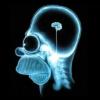These two herbal studies seem to contradict each other as relates to activity at DOR for epicatechin which makes me speculate into how meritorious the kappa antagonist study on flavonoids actually is:
http://www.ncbi.nlm....93/#!po=21.4286 Flavonoid study on KOR antagonism
http://www.ncbi.nlm....les/PMC2993198/ Epicatechin - DOR agonist mediated effect
(I doubt DOR stimulation could have been some downstream effect...?)
Flavonoid study has low picolmolar Ke for JDTic...not sure if this is supported elsewhere offhand. Indeed it is potent.
Ke in that study for the most potent natural flavonoid compounds are noted 4 orders of magnitude less potent...hmmm...though they still have respectable moderate nM Ke as reported (in contrast though again to low picomolar for the two synthetic long-acting KOR antagonists).
Catechin and amentoflavone might seem promising, if not for some of these factors that appear to make such less potentially successful to engage.
There is a study for the antidepressant effect of Camellia senensis, which regarding
(+)-catechin that which was displayed of the flavonoids to have th second most significant antagonist KOR activity at 320nM. It is shown to be orally bioavailable (though not highly) and does cross the BBB as seen in a recent study. Half-life is ~3-4 hours.http://www.ncbi.nlm....pubmed/10617953 (half-life)www.ncbi.nlm.nih.gov/pubmed/21773584 (BBB study)I still highly feel it would be really interesting to see JDTic get trialed in enough number to really get an understanding of the compound and its impact on KOR(JNK1) in this 'KOR crushing' manner (lol) and the resulting effect. Unfortunately, that will not be seen in any clinical setting it appears, and perhaps not otherwise :( A quote I received from a respectable U.S. based research chem supplier was about $2500USD for 250mg; one advantage to hobbyist research costs is the potency is cost effective for dosing your mice or rats.
Though there is a note of one anecdotal report, there are actually two. The jdtic.com report where 100mcg EOD created highly positive effects, though after using 1mg+ dosing for days prior it appears that may skew the bio-assay, and the kappazappa report where 2mg/day was used seemingly successfully.
If the clinical for JDTic that removed this from the pipeline simply used a dose that was higher than necessary, lower dosing may have avoided the v-tach seen in the 2 of 6 in the trial. We may never know. :(
I do not think there will be a U-curve response from KOR antagonists, but extrapolate more research to come to any conclusion that is more solid than a hypothetical speculation.
Edited by VERITAS INCORRUPTUS, 06 April 2014 - 08:55 PM.






















































